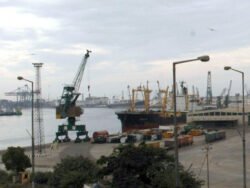The cannabis opportunity: A sustainable economic landscape for Pakistan

01 February 2024
Published in: Daily Times
In recent years, Cannabis has emerged from shadows of societal stigma, undergoing a transformative journey that opens up numerous opportunities in Industrial and Medicinal Cannabis industries. Stepping into the spotlight, cannabis has become a catalyst for change in healthcare, construction, textiles, and many more. Over 45 countries have embraced full or partial legalization of cannabis for medical use, reflecting a global shift in perspectives. The changing legal landscape has played a pivotal role in mainstreaming cannabis, creating opportunities for research, development, and commercialization.
Industrial Cannabis
Derived from Cannabis Sativa, Industrial Cannabis features less than 0.3% Tetrahydrocannabinol (THC) and a higher Cannabidiol (CBD) content, leading the charge in sustainable innovation. Its applications in textiles, construction materials, and food products are reshaping industries.
Medicinal Cannabis
Primarily derived from the Cannabis Indica/Sativa plant, medicinal cannabis offers a THC content greater than 0.3%, making it psychoactive and medically valuable. The medicinal applications of cannabis, particularly in the form of CBD and THC based products, have revolutionized pain management, providing therapeutic effects through interactions with the endocannabinoid system.
The Cannabis Revolution
Once overshadowed by its psychoactive properties, cannabis is now experiencing a paradigm shift, fueled by scientific discoveries and evolving societal attitudes. The unlocking of the cannabis genome, coupled with increased research, has unveiled its vast potential beyond recreational use. The realms of medicinal and industrial cannabis are at the forefront of this revolution, holding the key to a future marked by sustainability, innovation, and healing. More than 40 clinical trials have been conducted in the UK, USA, Switzerland, and other European countries to study the medical benefits of CBD and THC for treating various ailments.
Empowering Pakistan: Integrating into the Global Cannabis Market
As the global landscape embraces cannabis, Pakistan stands at a pivotal juncture with its existing cultivation spanning approximately 50,000 acres in Newly Merged Tribal Districts (NMTD) with a potential market value of approximately $3 Billion. Despite the potential for significant contributions to the booming international cannabis market, reservations about cannabis perception and misuse pose hurdles to legalization.
One of the objectives is to bring the existing cannabis cultivation into legal umbrella. Imposing a complete ban on recreational use, curbing illicit drug trafficking, providing enhanced incentives to growers, developing and manufacturing cannabis-based medicines for local use and export, and generating significant income tax revenue for both provincial and federal governments.
Global Model for regularization of illegal cannabis cultivation
Drawing parallels to Pakistan’s scenario, Morocco faced a similar situation with existing cannabis cultivation in the Rif region. However, Morocco took a decisive step to regularize its cannabis market, leading to substantial economic gains. The Rif region in Morocco, known for its extensive cannabis cultivation, has witnessed a remarkable transformation. By legalizing and regulating the cannabis industry, Morocco has tapped into a lucrative market, earning billions of dollars through exports and other related activities. The move has not only provided a legal framework for cannabis cultivation but has also significantly contributed to the national economy, demonstrating the potential benefits of embracing and regulating cannabis cultivation for countries facing similar challenges.
Greening Industries: The Sustainable Path of Industrial Cannabis
Pioneering sustainable innovation, industrial cannabis hailing from Cannabis Sativa, featuring less than 0.3% THC and a higher CBD content, is transforming various sectors. Its applications in textiles, construction materials, and food products are driving significant changes in industries worldwide. The market reached a value of USD 5.66 Billion in 2020 and is anticipated to achieve USD 23.72 Billion by 2030, reflecting a remarkable CAGR of 25.17% from 2021 to 2028.
The cultivation of industrial cannabis promotes renewable agriculture, requiring minimal pesticides and synthetic fertilizers. Its rapid growth and deep roots prevent soil erosion, making it an environmentally friendly choice. With its carbon-sequestering abilities, industrial cannabis emerges as a powerful ally in the fight against climate change.
For centuries, industrial cannabis has been a versatile raw material, used in multiple items from building materials to textiles. The recent surge in interest is reminiscent of industrial cannabis’s historical significance, from salt-resistant boat ropes to preserving ancient structures like the Ellora Caves. Its potential was even explored by Henry Ford, who produced a concept car in 1941 partly derived from industrial cannabis.
Utilizations of Industrial Cannabis: A Multifaceted Approach
The applications of industrial cannabis as a raw material are diverse. It can be transformed into premium textiles, paper, biodegradable plastics, and insulation building materials. Cannabis seeds, highly nutritious and rich in essential fatty acids, offer a sustainable substitute for edible oils. Additionally, cannabis-derived medicinal products demonstrate potential therapeutic properties, promising relief for various medical conditions.
However, the production of industrial cannabis comes with its set of challenges, both technical and regulatory. The choice between cultivating for fiber, seeds, or cannabinoids significantly impacts various production factors, requiring a meticulous approach to optimize yield along the value chain.
Revolutionizing Pakistan’s Textile Sector with Industrial Cannabis
Pakistan, renowned as the 8th largest textile exporter in Asia, achieved a remarkable milestone in the fiscal year 2022 with a staggering $18.31 billion in textile exports. As the industry seeks avenues for growth and diversification, a groundbreaking opportunity arises with the integration of Industrial Cannabis fibre into the textile landscape. The average import-to-export ratio of textiles, currently standing at 31%, suggests a promising potential to elevate export values further.
Infusing Cannabis fibre with traditional cotton presents an innovative approach to not only enhance the export basket but also amplify the export value. The allure lies in the fact that Cannabis fibre commands a premium price, promising lucrative returns. Importantly, the cultivation and processing of Industrial Cannabis fibre demonstrate a commendable commitment to sustainability, offering an eco-friendly alternative to conventional cotton.
A strategic competitive advantage emerges as Pakistan already boasts a robust fibre processing infrastructure. Unlike starting a textile industry from scratch, the incorporation of Cannabis fibre seamlessly integrates into existing setups, streamlining the transition. The sustainability of Industrial Cannabis extends beyond export potential, addressing environmental concerns. With inherent eco-friendly qualities, Cannabis fibre cultivation aligns with global efforts towards sustainable practices, making it a responsible choice for the textile industry. (Continued)





